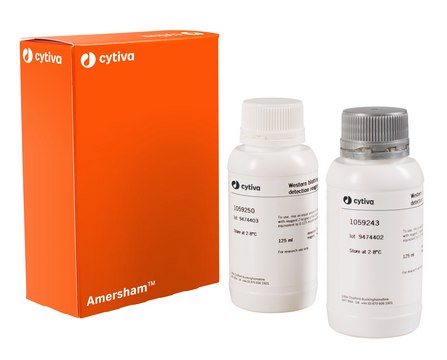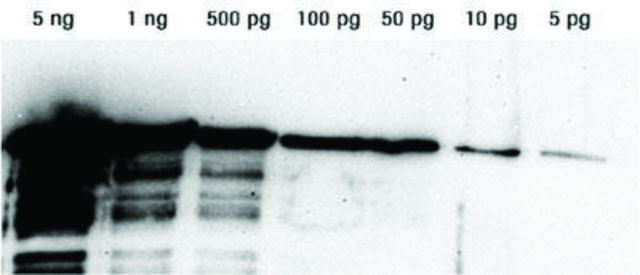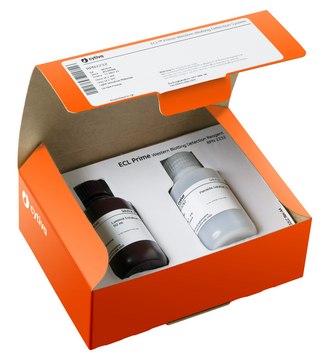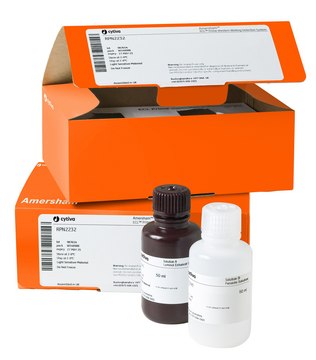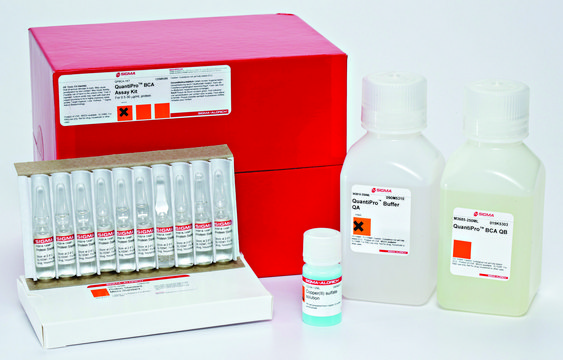12015200001
Roche
Lumi-Light Western Blotting Substrate
Synonym(s):
western blotting substrate
Sign Into View Organizational & Contract Pricing
All Photos(2)
About This Item
UNSPSC Code:
12352204
Recommended Products
packaging
pkg of 400 mL
manufacturer/tradename
Roche
storage temp.
2-8°C
General description
As the technology for quantifying chemiluminescence advances, the substrates for chemiluminescence must also advance. For instance, the light emission of conventional enhanced luminol substrates substantially decreases within 30 minutes. In contrast, the chemiluminescence signal of the Lumi-Light substrate persists for more than three hours, and since exposures of only a few minutes are necessary, multiple exposures can be taken. The emission wavelength of the Lumi-Light substrate is 425nm.
Application
Lumi-Light Western Blotting Substrate has been used in western blotting.
Lumi-Light Western Blotting Substrate is a chemiluminescent POD substrate for western blots. Routine detection of any antigen blotted on a PVDF or nitrocellulose membrane. It is suited for high-sensitivity routine western blotting, especially when quantification is required. The chemiluminescent signal persists for more than 3 hours, allowing multiple exposures to be taken.
Features and Benefits
- Detect rare proteins: Lumi-Light substrate detects antigen in the range of 10 - 50pg.
- Multiple exposures possible: The signal is stable for more than three hours after substrate addition.
- Save sample material: Lumi-Light substrate detects less than 50-pg amounts of antigen.
- Save primary antibody: Due to the strong signal of the Lumi-Light substrate, primary antibody can be diluted up to 10-fold more than with colorimetric detection systems.
- Easy preparation of substrate solution: Just mix the two Lumi-Light components in a ratio of 1:1.
Contents
Lumi-Light Luminol/Enhancer Solution, 2 x 100ml
Lumi-Light Stable Peroxide Solution, 2 x 100ml
Packaging
1 kit containing 2 components
Quality
Each lot is function tested using mouse or rabbit primary antibodies.
Specifications
Number of Tests: The reagent is sufficient for 40 blots, each with a size of 10cm x 10cm.
Sensitivity: Depending on the affinity of the primary antibody, 10 - 50pg of antigen can be detected
Sensitivity: Depending on the affinity of the primary antibody, 10 - 50pg of antigen can be detected
Other Notes
For life science research only. Not for use in diagnostic procedures.
Kit Components Only
Product No.
Description
- Lumi-Light Luminol/Enhancer Solution
- Lumi-Light Stable Peroxide Solution
Storage Class Code
12 - Non Combustible Liquids
WGK
WGK 1
Flash Point(F)
does not flash
Flash Point(C)
does not flash
Regulatory Information
新产品
Choose from one of the most recent versions:
Already Own This Product?
Find documentation for the products that you have recently purchased in the Document Library.
Bing Zhang et al.
PloS one, 8(3), e58758-e58758 (2013-03-22)
Two-dimensional gel electrophoresis (2-DE)-based proteomics approach was applied to extensively explore the molecular basis of plant development and environmental adaptation. These proteomics analyses revealed thousands of differentially expressed proteins (DEPs) closely related to different biological processes. However, little attention has
Suppression of type 1 Insulin-like growth factor receptor expression by small interfering RNA inhibits A549 human lung cancer cell invasion in vitro and metastasis in xenograft nude mice.
Qian J, et al.
Acta biochimica et biophysica Sinica, 39(2), 137-147 (2007)
Flow Cytometric Analysis of HIV-1 Transcriptional Activity in Response to shRNA Knockdown in A2 and A72 J-Lat Cell Lines.
Boehm D and Ott M
Bio-protocol, 7(11), e2314-e2314 (2017)
c-MYC targets the central oscillator gene Per1 and is regulated by the circadian clock at the post-transcriptional level.
Repouskou A and Prombona A
Biochimica et Biophysica Acta - Gene Regulatory Mechanisms, 1859(4), 541-552 (2016)
Clenbuterol Induces Cell Cycle Arrest in C2C12 Myoblasts by Delaying p27 Degradation through β-arrestin 2 Signaling.
Chen M, et al.
International Journal of Biological Sciences, 13(10), 1341-1341 (2017)
Our team of scientists has experience in all areas of research including Life Science, Material Science, Chemical Synthesis, Chromatography, Analytical and many others.
Contact Technical Service![Western Blocking Reagent, Solution solution, sufficient for 10 blots (11921673001 [100 cm2]), sufficient for 60 blots (11921681001 [100 cm2])](/deepweb/assets/sigmaaldrich/product/images/352/091/ef743cea-ccd8-44f1-8f3b-dec5a1e4f5d1/640/ef743cea-ccd8-44f1-8f3b-dec5a1e4f5d1.jpg)
